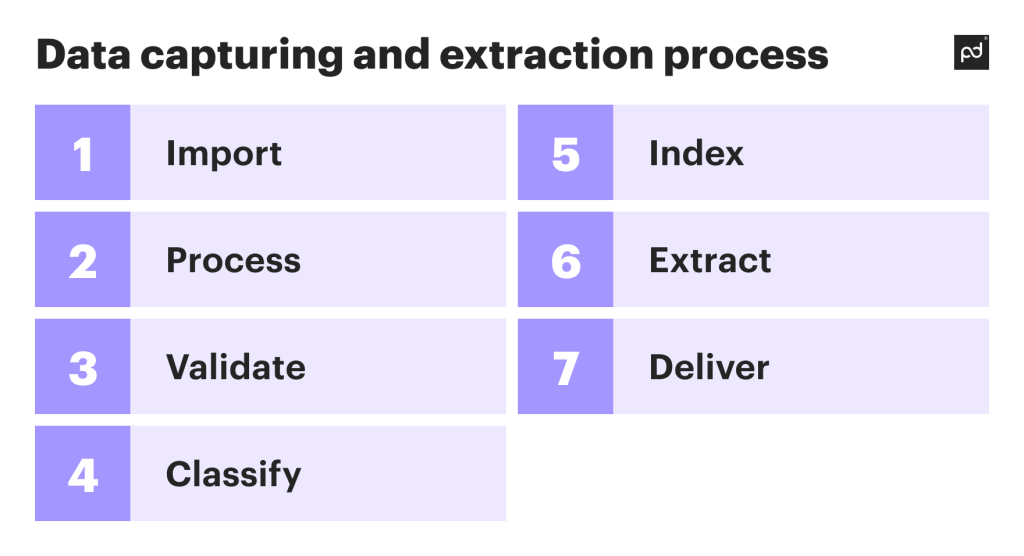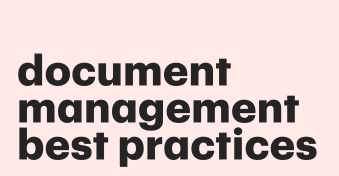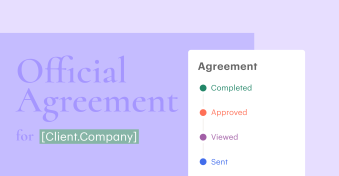Navigating through massive piles of paper documents scattered all over the place or sorting out files on your digital desktop is no easy task.
It consumes your time and kills efficiency.
If you leverage technology to reorganize and streamline document-related processes, you can save your employees up to 50% of their time wasted on manually creating and preparing documents.
Besides, if your employees eliminate the need for pen and paper and start using electronic and automated solutions, that alone can boost your close rates by 36%.
When you have a faster turnaround, it gives your team the advantage of closing more deals.
A true game-changer, document capture paves the way for unparalleled speed and agility in the business landscape.
This article will discuss how new directions in document management solutions can benefit businesses and individuals and support nonprofit projects.
It also shines a light on the disruptive role of omnipresent AI.
Key takeaways
- Businesses that use document capture can save up to half the time their employees spend on manual document preparation.
- Switching to document capturing and e-signature solutions can help businesses boost close rates by 36%.
- Benefits of document capture include cost savings, increased security, a more green-friendly approach, and enhanced efficiency, accuracy, and accessibility of data.
- AI enhances document capturing and offers advanced language understanding, image recognition, and data extraction from unstructured documents.
- Document capture can improve business operations across various industries and also helps nonprofit organizations.
- Document capture is not just for businesses but also suits individuals, startups, and households.
Understanding document capturing
Document capturing has quietly emerged as the unsung hero of data management.
It is similar to taking snapshots of physical paper documents or digital files, saving them in electronic storage space, and then converting them into machine-readable formats.
In slightly more intricate terms, this process revolves around optical character recognition (OCR) and advanced machine learning algorithms that help transform static texts and images into dynamic, actionable data.
The role of OCR-based document capturing in facilitating data extraction, analysis, and storage might escape the spotlight; however, the global document management system market is nonetheless expected to reach $11.3 billion by 2029, with a CAGR of 8.6% during the next decade.
Input documents may vary from invoices, medical receipts, and business contracts to research papers, tax forms, and random handwritten notes.
With document capture, you can scan, organize, and upload different types of documents.
After that, you can easily access them whenever you want without digging through stacks of papers or folders on your computer or physical desktop.
Trimming costs with document management
The traditional document processing landscape has been plagued by substantial costs imposed on businesses and burdening the environment.
Manual invoice handling, in particular, incurs an average cost of around $10.89 per document.
However, document capturing provides relief by automating the laborious and prone-to-human-error manual data entry process.
By implementing digital document processing within your organization, you can maintain and/or increase revenue by 35%, propelled by the high speed and precision in extracting information that document capturing offers.
Document capture technology not only promises substantial benefits to businesses and individuals but also reduces costs and paves the way for a greener and more efficient future.
Key benefits of document capture and management
Among the multiple benefits of document automation, five key ones shine out.
These perks make automated document management systems an indispensable choice.
Make data easily accessible
Authorized users can effortlessly access documents from any corner of the world.
Scanned files will safely reside in the cloud or any other document storage system.
Increase staff efficiency and personal productivity
It’s not solely about documents; it’s also about automated workflows that businesses and individual users seek.
Employees of large organizations or managers of their own projects can complete tasks swiftly and accurately and boost productivity.
Reduce costs
Processing large volumes of paper documents becomes less expensive with document management software in place.
It helps cut costs by eliminating the need for physical storage space and streamlining time-consuming manual processes.
Make documents more secure
74% out of all recent global data breaches resulted from the human element — from mistakes to misuse to outright hacks.
AI-powered data capture offers an impeccable accuracy rate, preventing a majority of costly human errors from happening.
Go paperless — go green
Document capturing not only benefits workflow but also leaves a positive impact on the environment.
While users transform paper emails into electronic documents, they contribute to the conservation of natural resources and reduce power consumption.
Different forms of document capture: Tech under the hood
There’s no magic behind document capturing, at least after the tech side of it has been revealed.
Let’s get granular on the cornerstone technologies forming document management solutions, and the ways they contribute to guiding businesses toward unparalleled efficiency and data-driven success.
Optical character recognition (OCR)
At the core of document capturing, OCR uses pattern recognition, image processing, and machine learning algorithms.
It helps discern and interpret characters from printed and handwritten documents, converting them into machine-readable ASCII or Unicode text.
Intelligent character recognition (ICR)
Intricate handwriting styles are tough to decipher, but ICR allows doing so using neural networks and deep learning models to understand stylized handwriting challenges.
Iterative training for neural networks helps continuously improve recognition accuracy.
Optical mark recognition (OMR)
Surveys and answer sheets that are widespread in the realm of education require digitization.
Image processing algorithms help detect and analyze pencil or pen marks on predefined areas and extract binary data for swift data analysis.
Optical barcode recognition (OBR)
As the name implies, this technology hinges on pattern recognition and image processing to decode both 1D and 2D barcodes, effectively extracting encoded information and streamlining inventory management and logistics.
Free-form extraction
Advanced NLP techniques and machine learning algorithms made it possible to parse unstructured data and identify such elements as tables, paragraphs, and diagrams to yield accurate insights from complex documents.
Deconstructing the data capturing and extraction process
When you need to scan a document and capture data, be sure to find and apply the most efficient tool for seamless process automation even as the underlying mechanisms, the baseline tech, remains unchanged.

- Import. You import your document into the system. It can be a paper document you scanned or a digital file uploaded from your email or cloud storage.
- Process. Now let the system work its magic to process the information. With some data capture wizardry like OCR, it will convert text and images into a digital format.
- Validate. The system will check the output for any errors or mistakes in the captured data. Having an extra pair of eyes is a good idea to ensure the accuracy of the information you’ll be working with.
- Classify. After checking the data, the system will organize your documents based on their type, content categories, and so forth. This smart classification helps keep documents in order and quickly access them whenever there is a need.
- Index. Like other users, you want a super-fast way to search and retrieve specific information from your documents. The indexing step enables swift data retrieval by creating an index of key data points.
- Extract. The system will extract all the important data elements, including names, dates, or amounts. No more hunting through pages and pages since you will have the relevant information right at your fingertips.
- Deliver. With everything set and the data extracted, your captured data is now ready for using it in other systems or databases. It seamlessly flows to where you need it, facilitating your work.
Now you can confidently scan various types of documents and store valuable or confidential data in cloud-based repositories, ready to use to boost your productivity. You can also use eSignature for your electronic documents, which is a time-saving way to sign paperwork.
How AI enhances document capturing
Document capture and management software become intelligent when AI comes on board.
It is not just about AI hype: if OCR or free-form extraction is paired with AI, the quality of the output improves dramatically.
AI brings advanced language understanding, image recognition, and natural language processing to the table.
That enables document management solutions to extract structured data from unstructured documents and automatically suggest meaningful improvements for captured data.
Powerful AI models find ways to augment various software, enhancing the user experience.
AI built-in document management software can now write documents or fill out forms instead of users, keeping to diverse styles and factoring into custom requests.
The trending language model that is sitting on everybody’s lips excels at analyzing textual content and understanding context.
This allows for extracting valuable information from documents of varying formats, layouts, and styles.
In addition, powerful image recognition capability allows users to capture data from physical documents, particularly challenging handwritten notes.
AI-driven software can automatically convert a snapshot of any scribbles into digital text and prepare it for editing and classifying.
Behind an AI-based model is natural language processing (NLP), the technology that allows AI to understand the content and context, and then identify essential information.
For example, legal firms can use NLP-enabled functionality to automatically tag documents as contracts, court filings, or client correspondence.
That would streamline the retrieval and management of documents.
When input documents are of low quality or contain noise, AI can help accurately identify and capture data fields.
AI can discern the relevant fields within handwritten forms and convert them into editable and searchable text.
AI helps keep in check data security and privacy matters.
Sensitive information within documents can get automatically detected and flagged, including personally identifiable information and confidential data.
In the healthcare industry, where patient privacy is crucial, AI can detect and protect sensitive medical information, prevent unauthorized access, and maintain HIPAA regulatory compliance.
Recharging businesses efficiency
Document capturing is a transformative power across various business areas.
It can dramatically improve productivity and revitalize operations.
Finance and banking
Businesses in the financial sector often bog down in piles of invoices and customer documents.
With automated document capturing and management, businesses can achieve a new level of data accuracy.
They can extract data from invoices in real-time, easily access, share, and store customer documents, and swiftly check if strict industry regulations are met.
HR processes automation
Once paper documents reigned supreme in the human resources domain. Today document management software is a must-have for HR workflows.
Having digital records, HR professionals can easily optimize talent management.
They can swiftly make background checks for candidates, speed up onboarding, and maintain order in employee records.
Healthcare
Document capturing and management solutions have become a lifeline of efficiency for medical institutions.
Digital medical records help healthcare professionals improve diagnoses and treatment decisions.
Patient data becomes secure and well-organized assets, easily flowing between departments, which fosters collaboration while maintaining data privacy.
Traveling
The travel industry is always on the move and needs reliable document management software as a companion.
Document capture drives the industry towards greater customer satisfaction.
Easily scanning documents like passports and visas makes border crossings smooth, which is the beginning of every great trip or journey.
Business travelers can also scan receipts automatically and easily report expenses using zero paperwork.
Document capture makes a social impact
Nonprofit and humanitarian organizations require technologies to elevate entire document processes at the same high scale as other businesses do.
With document capture and AI-powered tools, their aspirations and goals to make the world a better place become easier to attain.
And whether the volumes of archived data are relatively small or fairly massive, inexpensive document automation can help retrieve, process, and share documents easily as per a user’s request.
Technology in emergency response
One of the key technology applications in the chaos and urgency of a disaster is digitizing medical records.
Medical teams require immediate access to patients’ histories, prescriptions, and lab reports to deliver timely and adequate care.
In addition, document capture empowered by AI helps non-medical responders and decision-makers extract information from an influx of paper-based reports to identify missing persons.
Text and critical information extracted from maps and satellite images assist in identifying areas that require immediate attention.
Google Arts & Culture project digitizes historical documents
Google collaborated with various museums and cultural institutions worldwide to digitize and gather an impressive online collection of historical documents.
They used OCR technology and document scanners to extract and index the text from these documents, and now researchers everywhere and the global public can explore and learn from cultural heritage artifacts.
Envision AI assists the visually impaired
Envision is a reliable app that assists people with visual impairments.
People can use their mobile devices to scan and read texts from physical objects, including books, documents, labels, and signs, and convert them into speech.
It helps users navigate and interact with their surroundings independently.
UNESCO Memory of the World
UNESCO’s Memory of the World program aims to preserve and promote the world’s documentary heritage.
They have engaged in various projects to digitize historical documents and archives, using OCR technology to make these records searchable and accessible.
Translating printed texts using OCR
AI-powered language translation services equipped with OCR can convert printed text into digital format and then translate it accordingly.
This way, educational materials can be translated into multiple languages, making them more inclusive and accessible to a broader audience and promote cultural diversity.
Document capturing for individuals, startups, and households
A modern-day multitasker needs document capturing and management to handle paper chaos and bring personal organization and productivity to the next level.
Document management software is here to help.
There’s no more need to hunt for birth certificates or passports buried beneath a mountain of papers.
It’s enough to snap a photo, scan personal documents, and get essential records neatly digitized and sorted.
Likewise, medical documents can accumulate quickly and are often supposed to be stored for a long period.
Digitizing these paper files and recent electronic reports has become easier with document capture and management software.
The medical history will be at users’ fingertips and readily accessible at any time.
Modern technologies help alleviate the burden of paying taxes and utility bills.
Document capturing allows reading invoices, contracts, and receipts automatically.
With a few taps, users can have a virtual record of their financial lives that can make a tax season seamless for them and leave space for more important matters.
Document capturing also extends its potential to users who need to sort out electronic and paper-based correspondence.
With a snap of a screenshot or photo, users can swiftly digitize their messages and keep them safely alongside other essential documents.
Some dream projects and side hustles may require accurate document handling.
Records management can help read and save plans, sketches, inspiration boards, and so forth to meticulously preserve ideas and insights and keep them ready to spring into action.
Explore PandaDoc’s document management software
Document capture and AI are shaking up practices that business owners have established for handling paperwork.
Businesses can cut manual document preparation time in half and see an increase in close rates.
Similarly, technologies help nonprofit organizations and make everyday life easier for people juggling their personal papers.
Using PandaDoc, you can easily create, manage, and add e-signatures to your digitized documents, staying on top of both version and access control.
Our platform easily integrates with native CRMs, making your whole document flow seamless.
PandaDoc’s intuitive, modular functionality will perfectly meet your business and individual needs.
You can achieve high-quality document processing regardless of budget parameters.
To uncover the full potential of PandaDoc’s document management software, schedule a 15-minute demo today!
Disclaimer
PandaDoc is not a law firm, or a substitute for an attorney or law firm. This page is not intended to and does not provide legal advice. Should you have legal questions on the validity of e-signatures or digital signatures and the enforceability thereof, please consult with an attorney or law firm. Use of PandaDocs services are governed by our Terms of Use and Privacy Policy.


